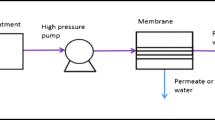The process of emulsion separation using an intensifying device tested on the developed mobile well production treatment unit was subjected to quantitative analysis followed by approbation. During tests, cassettes were mounted in the sump of the mobile unit with a distance of 5 mm (standard design) and 2.5 mm between the plates. Experiments were conducted with some variation: with the fluid entering the horizontal sump from the top and from the side, process temperature varying from 60 to 70°C, and with varying fresh water flow rates. It was found that the smaller distance between the plates ensures turbulent diffusion in the intensifying devices, leading to a more intensive oil treatment. It was also found that desalting processes proceed more intensively at 70°С than at 60°C and when fresh water flow rate is increased by 10 and 20%. A 30% increase in the flow rate of fresh water leads to an appreciable increase in the fraction of water in the treated drip oil, the desalting process deteriorates. The study showed that the use of intensifying devices with a distance of 2.5 mm between the plates leads to improved oil treatment: water cut decreased by 2–37% and the content of chloride salts decreased by 5–74% depending on the process.






Similar content being viewed by others
References
M. S. Turbakov and E. P. Ryabokon, “Improvement of the efficiency of cleaning petroleum pipelines to remove paraffin deposits,” Vest. Perm. Nats. Issled. Politekhn. Univ. Geolog. Neftegaz. Gorn. Delo, 14, No. 17, 54–62 (2015).
A. V. Lekomtsev, P. Yu. Ilyushin, and D. A. Shishkin, “Technology of cluster preparation and injection of bottom water into the reservoir using a pipe divider of phases,” Ekspoz. Neft Gaz, No. 7 (53), 85–88 (2016).
R. M. Galimov, G. N. Chumakov, and S. E. Burtasov, “Evaluation of the energy efficiency of the commercial well production system of TsDNG No. 7 of LLC LUKOIL-Perm,” Vest. Perm. Nats. Issled. Politekhn. Univ. Geolog. Neftegaz. Gorn. Delo, No. 7, 35–46 (2013).
G. P. Khizhnyak, A. V. Usenkov, and E. N. Ustkachkintsev, “Complicating factors in the development of the Nozhov Group of deposits of LLC LUKOIL-Perm,” Vest. Perm. Nats. Issled. Politekhn. Univ. Geolog. Neftegaz. Gorn. Delo, 13, No. 13, 59–68 (2014).
V. P. Tronov, A Commercial Preparation of Oil, Nauka, Moscow (1977).
E. N. Ustkachkintsev and S. V. Melekhin, “Determination of the effectiveness of methods for preventing asphaltene-resin-paraffin deposits,” Vest. Perm. Nats. Issled. Politekhn. Univ. Geolog. Neftegaz. Gorn. Delo, 15, No. 18, 61–70 (2016).
G. S. Lutoshkin, Oil, Gas and Water Gathering and Treatment, Nedra, Moscow (1979).
L. P. Pergushev and A. K. Rozentsvaig, “Effect of inhomogeneity of the disperse phase on coalescence and mass-transfer processes in liquid emulsions,” Prikl. Mekh. Tekh. Fiz., No. 4, 74–81 (1980).
A. A. Zlobin, “Experimental studies of the processes of aggregation and self-assembly of nanoparticles in oil dispersed systems,” Vest. Perm. Nats. Issled. Politekhn. Univ. Geolog. Neftegaz. Gorn. Delo, 14, No. 15, 57–72 (2015).
O. V. Tretyakov, A. V. Usenkov, A. V. Lekomtsev, et al., “Results of pilot-industrial tests of a mobile unit for well production preparation,” Neft. Khoz., No. 12, 131–135 (2016).
Patent 2616466 RF, “Well production preparation setup.”
B. S. Sazhin, M. P. Tyurin, L. Ya. Zhivaikin, et al., “Processes of destruction of armor shells of drops of stable emulsion in a turbulent flow,” Usp. Khimii Khim. Tekhnol., 21, No. 6 (74), 70–73 (2007).
Author information
Authors and Affiliations
Corresponding author
Additional information
Translated from Khimicheskoe i Neftegazovoe Mashinostroenie, No. 4, pp. 3–7, April, 2018.
Rights and permissions
About this article
Cite this article
Lekomtsev, A.V., Ilyushin, P.Y. & Martyushev, D.A. Experience of Implementing an Intensifying Device on the Developed Mobile Well Production Treatment Unit. Chem Petrol Eng 54, 213–219 (2018). https://doi.org/10.1007/s10556-018-0465-4
Published:
Issue Date:
DOI: https://doi.org/10.1007/s10556-018-0465-4




